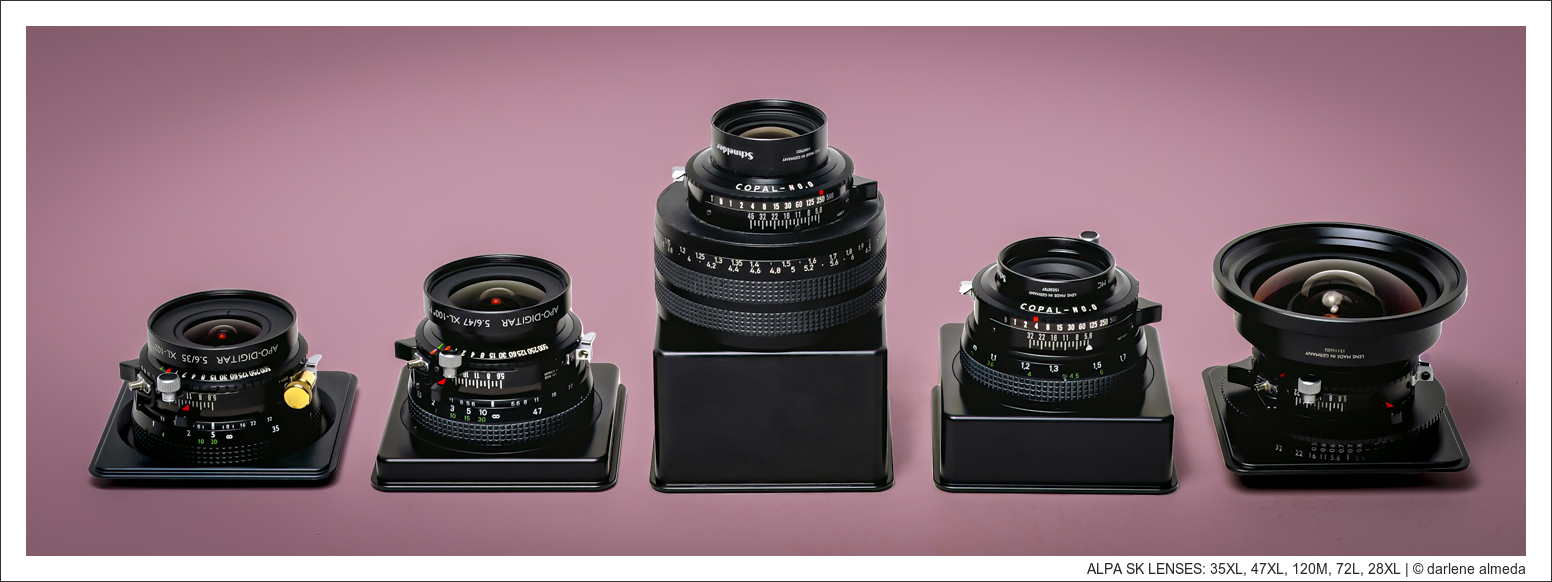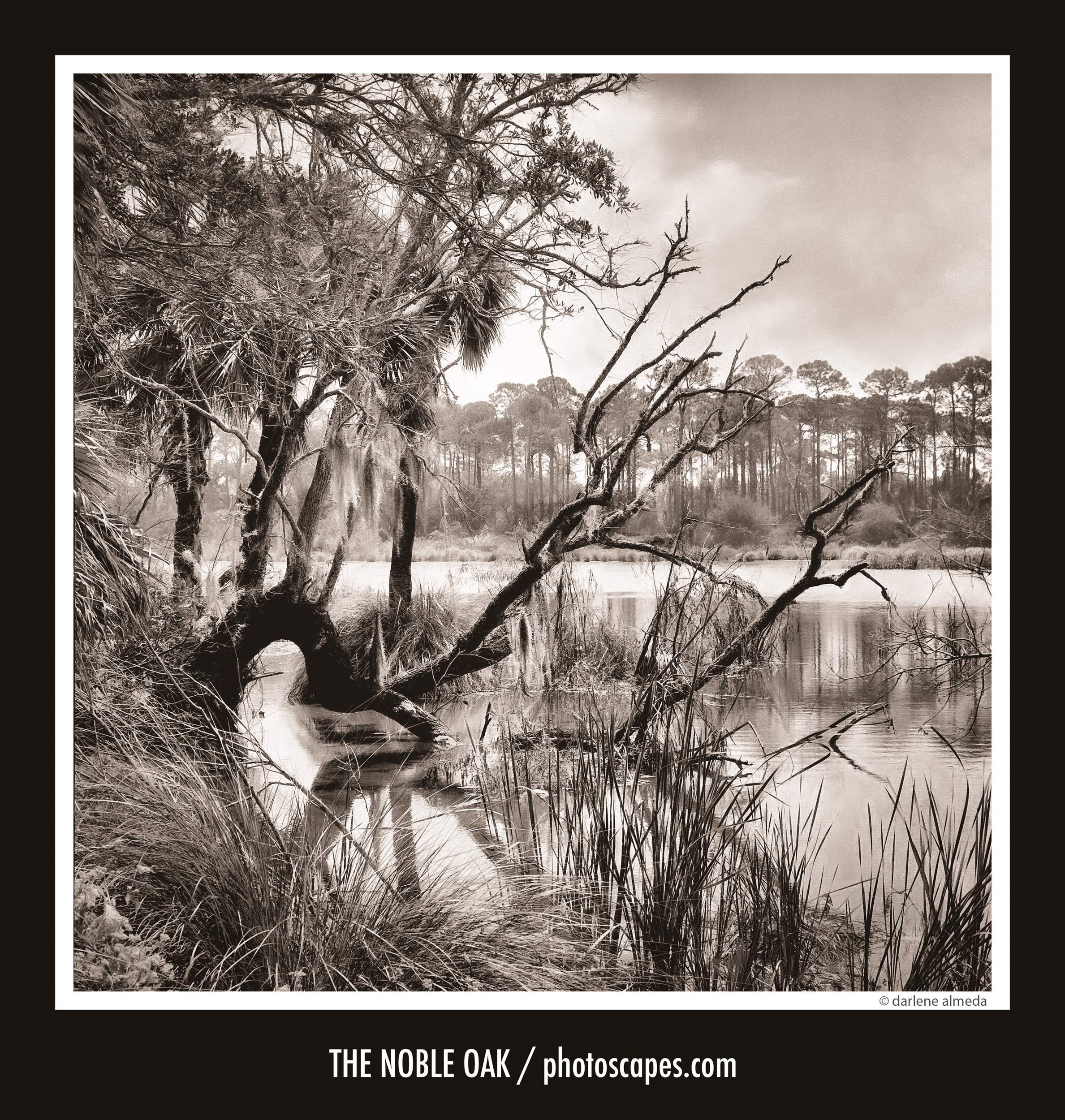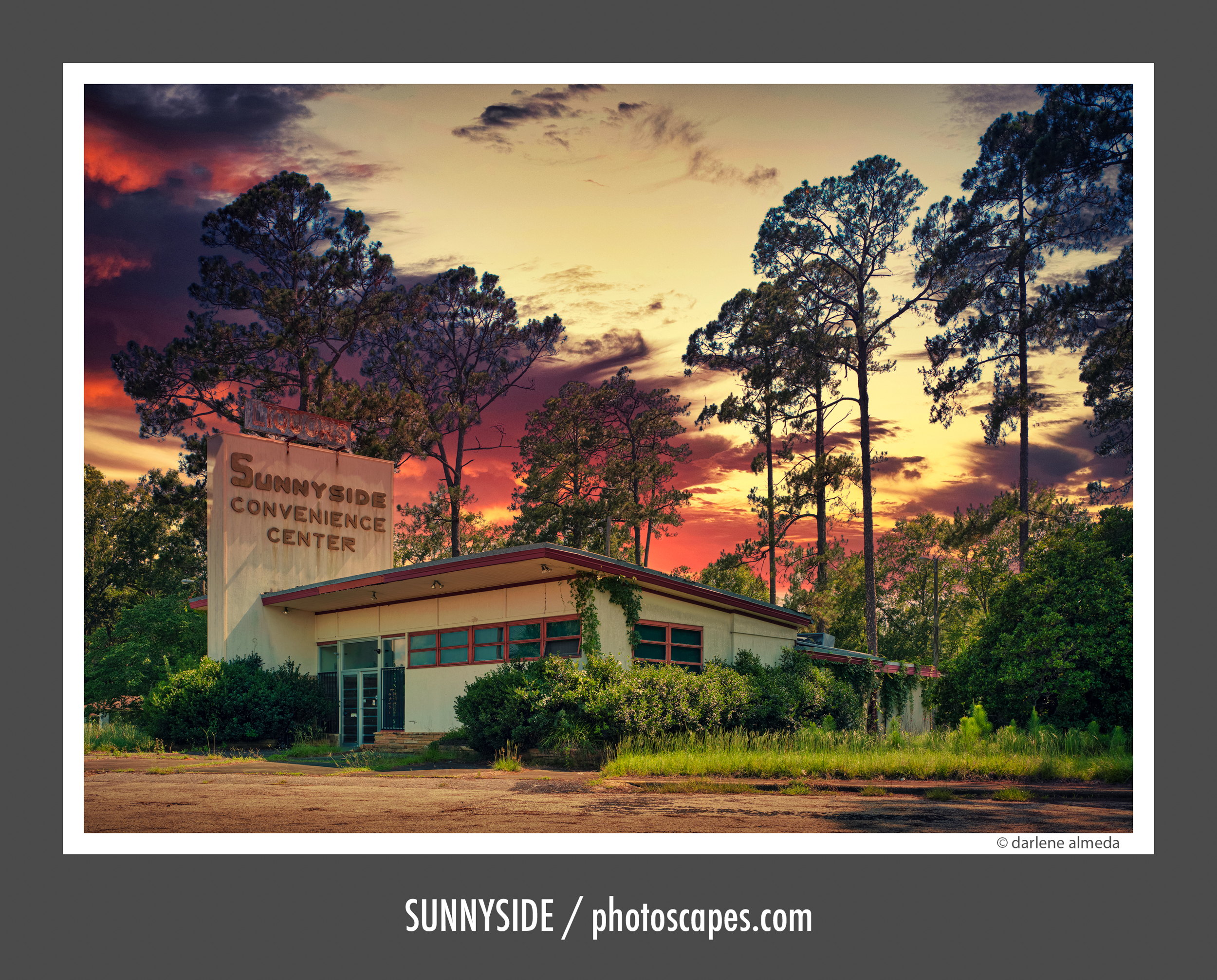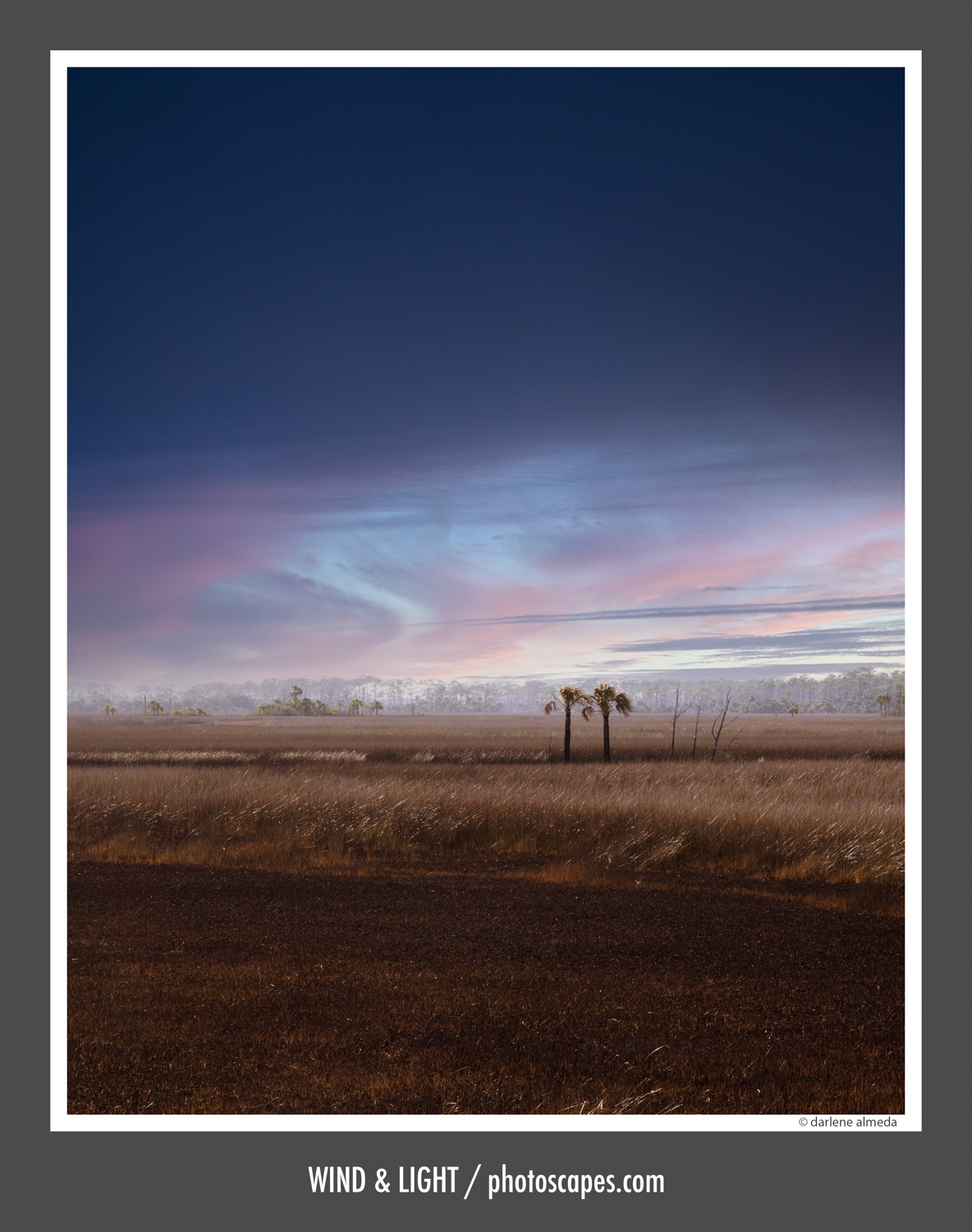
72/5.6 SUPER ANGULON XL, 150/5.6 SUPER SYMMAR XL, 120/5.6 M DIGITAR,
150/5.6 L SYMMAR, 210/6.8 DIGITAR
INTRO
My first large-format lens was a brand-new Schneider 210mm f/5.6 Symmar MC, which I purchased for use with my first 4×5 camera—a Calumet monorail—while studying commercial photography. My focus was on food and product photography, and that lens proved to be incredibly sharp and dependable in the studio. Over the years, Schneider large-format lenses have remained among the best I’ve owned and used.
Today, I continue to rely on Schneider lenses—now in ALPA mounts for my technical cameras and Sinar DB mounts for studio work. They’ve remained a core part of my toolkit.
Some of the older Schneider-Kreuznach lenses are known to develop what’s been nicknamed “Schneideritis”—tiny white dots that may appear on the black internal paint of the lens housing. I’ve never had a lens with this issue, but from what I’ve read, it doesn’t affect image quality, as the marks are on the housing, not the glass. In contrast, issues like fungus, haze, or etched patterns in the elements can significantly degrade a lens—but Schneideritis is primarily cosmetic. My experience with Schneider lenses has always been positive, with consistently excellent results.
Below are the current ALPA-mounted Schneider lenses I’m using. I began working with the ALPA system in 2012 and chose Schneider as my preferred lens manufacturer for their superior quality and large image circles. Unfortunately, these beautiful lenses are no longer in production, which makes them all the more special.
SCHNEIDER LENSES:
58/5.6 Super-Angulon XL MC,
65/5.6 Super-Angulon MC,
120/5.6 M Apo-Digitar,
135/5.6 Apo-Symmar,
150/5.6 Apo-Symmar MC,
210/5.6 Apo-Symmar MC
ALPA-SCHNEIDER LENSES:
Apo-Helvetar 28/5.6 XL,
Apo-Digitar 35/5.6 XL,
Apo-Digitar 47/5.6 XL,
Apo-Digitar 72/5.6 L,
Apo-Digitar 120/5.6 M
SINAR-SCHNEIDER LENSES:
Symmar 150/5.6 in DB Mount,
Symmar 150/5.6-265/12 Convertible in DB Mount
SCHNEIDER CENTER FILTERS:
IVd (Apo-Helvetar 28/5.6),
IIf (Apo-Digitar 35/5.6),
II (Apo-Digitar 47/5.6)
FILTERS:
B+W Brand Filters by Schneider (various & many)
LITERATURE & OTHER INFO AVAILABLE:
Dating Your Schneider Lens
Schneider Center Filter Guide (older)
Schneider Center Filter Guide (newer)
Schneider Super-Angulon Lenses
ALPA-SCHNEIDER LENSES
ALPA SK LENSES: 35XL, 47XL, 120M, 72L, 28XL
Lenses are indispensable tools for photographers. They are highly coveted for their quality, albeit often carrying a hefty price tag for top-tier options.
One such prestigious brand is ALPA, which I embraced early in my photography journey. Transitioning from large format film to medium format digital, ALPA became my second medium-format digital camera system after my initial setup focused around the Arca Swiss ML2 fell short. Despite its steep cost, the quality of ALPA lenses proved unmatched. Starting with the SK Digitar 72 L and the 43 XL, I added a used SK 120 M for specific product work. Over time, I acquired the SK 28 XL and the SK 35 XL from the used market. Each lens serves a distinct purpose, with the SK 28 XL demanding more attention due to its specialty wide-angle nature, while the 35 XL hits the sweet spot in my kit.
However, ALPA no longer offers SK lenses in their mounts, as Schneider Optics discontinued this line when Copal shutters ceased production. Despite my preference for the smaller size and asymmetric design of ALPA’s SK lenses over Rodenstock’s, I remain open to the latter’s offerings.
As I contemplate acquiring a CFV 100c in the future, primarily for its BSI sensor rather than its 100 megapixels (which would necessitate a new computer), I’m prompted to reassess my need for all my ALPA lenses. With the high resolution of 100 megapixels, cropping becomes a viable option, encouraging me to reconsider my lens collection.
Let’s now look at each lens pictured above in greater detail. I used this Depth of Field (DoF), Angle of View, and Equivalent Lens Calculator for the calculations.
ALPA HELVETAR 28/5.6
HELVETAR 28/5.6: Data Sheet & MTF Chart
This is a much sought-after lens if you specialize in architectural or landscape photography. It epitomizes the pinnacle of extreme wide-angle optics, with minimal distortion owing to its partially symmetrical construction and remarkably short flange focal length. Schneider spared no effort in ensuring seamless integration with the ALPA system, pushing boundaries to deliver unmatched performance.
The ALPA Helvetar 28/5.6 mm version features an exclusive HPF-like distance scale in meters, supplemented by a mirrored 180-degree scale in feet, all within its square mount, enabling versatile positioning. A generous 90mm image circle allows ample room for adjustments when paired with digital backs. This lens captures an image area akin to a 22mm lens on a 35mm format camera, making it ideal for photography in the tightest spaces with its short focal length and expansive 115° viewing angle.
However, its susceptibility to oblique ray paths presented a challenge for digital backs with pixel sizes below 9 or 6.8 microns, often resulting in significant color casts that were challenging to rectify until BSI sensors became available. The inclusion of a special center filter offers some relief with color casts when used with a non-BSI sensor.
This lens remains unparalleled for high-resolution achromatic digital backs and black-and-white photography. It delivers exceptional imaging performance in a lightweight and compact form.
Key Features:
- 90mm image circle
- resolution: 80/lp
- 10-element design
- expansive 115° viewing angle
ALPA DIGITAR XL 35/5.6
DIGITAR XL 35/5.6: Data Sheet & MTF Chart
The ALPA DIGITAR 35/5.6 XL Lens with Copal #0 Shutter is a highly specialized large-format lens tailored for digital backs. It was designed to excel even at larger apertures to prevent degradation from diffraction and maintain peak performance at its widest settings.
It has been recommended for use with backs as large as 37x49mm. This lens captures an image area akin to a 28mm lens on a 35mm format camera, making it ideal for tight-space photography with its short focal length and expansive 102° viewing angle. For larger backs nearing the lens’ maximum coverage, optimal performance is achieved with the recommended Schneider #08-1003286 center filter.
This is a much sought-after lens as it has a small footprint and is lightweight. I have had my copy for years and find it my go-to wide-angle choice.
For a fair price, I found a new center filter (CF) at Linhof Studio in the UK. Using the 35 XL with my P45 back did not prompt the use of the CF, but after upgrading to the CFV50c, I began my search for the CF and was lucky to locate one, as these are difficult to find. Overall, this lens is an excellent tool in my ALPA toolbox, and I recommend it if you need a small, lightweight wide-angle.
Key Features:
- designed for extremely high resolution on digital backs up to 37x49mm
- fitted with a conventional Copal #0 shutter
- delivers an exceptionally fine, uniform 90mm image circle
- a wide-angle view with expansive 102° coverage
- apochromatic design eliminates color fringing
- ideal aperture range of f/5.6-11
- compatible with 52mm threaded filters
- compact rear barrel with a minimal flange back, facilitating use across a range of cameras
- optional 08-1003286 center filter for enhanced performance
ALPA DIGITAR 47/5.6 XL
DIGITAR XL 47/5.6: Data Sheet & MTF Chart
The ALPA Schneider 47mm f/5.6 Apo-Digitar XL Lens, equipped with a Copal #0 Shutter, is a specialized wide-angle lens designed for digital back use where demanding high resolution and color-accurate image circles of a reduced size are essential. Digital backs particularly benefit from using larger apertures to circumvent image quality loss due to diffraction, making this lens ideally suited for use at its full aperture at all times.
Recommended for backs up to 63x63mm, this lens delivers a field of view akin to a 37mm lens on a 35mm camera, offering a broad perspective onto the sensor. Its short focal length and wide 100° viewing angle make it perfect for photographing confined spaces, architectural subjects, and scenarios where space is limited.
Key Features:
- designed for digital backs as large as 63x63mm
- copal #0 shutter
- 113mm image circle
- wide-angle view with 100° coverage
- apochromatic design to eliminate color fringing
- ideal working aperture range of f/8-11
- 52mm threaded filters
- small rear barrel with minimal flange back
ALPA APO DIGITAR 72/5.6 L
ALPA APO DIGITAR 72/5.6 L: Data Sheet & MTF Chart
The ALPA Schneider 72mm f/5.6 Apo Digitar L Lens is a telephoto lens tailor-made for medium-format digital photography, delivering images with high resolution and precise color accuracy within compact image circles. Its design caters specifically to digital backs, allowing for optimal performance at wider apertures to prevent the loss of image quality due to diffraction. This lens is equipped with a standard Copal #0 shutter for reliability and ease of use.
Suitable for digital backs up to 63x63mm, the 72mm Digitar captures an image field comparable to a 64mm lens on a traditional 35mm format camera, making it a versatile choice for both on-location and studio photography. It maintains consistent sharpness across a wide range of reproduction ratios, and its 90mm image circle is preserved across all apertures, including its maximum of f/5.6. This consistency in image circle size, alongside its exceptional sharpness at f/5.6, allows it to surpass the image quality of any medium format SLR lens when used with 6×7, 6×6, and 645 format film backs.
Digital photography often outshines traditional film photography, especially for print outcomes, by requiring lenses that can reproduce intricate details within the constrained area of a digital sensor. The 72/5.6 L Digitar lens excels in leveraging the full potential of your digital back, ensuring maximum image quality and detail capture.
Key Features:
- high-resolution lens for digital backs as large as 63x63m
- apochromatic color correction for excellent edge delineation across the entire field
- produces extremely fine, uniform 90mm image circle
- lens coverage remains identical at all apertures, including f/5.6 maximum aperture
- can be used with 6×7, 6×6, and 645 film backs to provide superior image quality
- mounted in conventional copal shutter
- telephoto view with 62° maximum coverage
- ideal working aperture range of f/5.6-11
- accepts 40.5mm threaded filters
- small rear barrel, minimal flange back
ALPA SK APO DIGITAR 120/5.6 M
ALPA SK APO DIGITAR 120/5.6 M: Data Sheet & MTF Chart
The ALPA Schneider 120mm f/5.6 Apo Digitar M Lens stands out as a macro specialist for medium-format digital backs designed for smaller, highly detailed, and color-accurate image circles. Its performance in macro photography at high reproduction ratios surpasses that of any standard lens. To prevent image quality loss due to diffraction, this lens thrives at its maximum aperture of f/5.6, although it allows stopping down to f/8 for 1:1 macro shots and f/11 for distances beyond 1:2. It is equipped with a standard Copal #0 shutter.
Suited for digital backs up to 63x63mm, the 120mm Digitar M’s design ensures optimal image quality at maximum aperture and includes sufficient rear flange distance to accommodate an internal mirror, making it adaptable to 35mm digital SLR cameras as well as 6×6 and 645 film backs. This adaptability offers superior image quality over conventional SLR lenses, which are often compromised by the need to fit around an internal viewfinder mirror.
Key Features:
- focal length: 120 mm
- focal length effective: 124.9 mm
- equivalent 35 mm @ 33×44 mm : 98 mm
- equivalent 35 mm @ 40×54 mm : 80 mm
- image circle: 110 mm
- shift @ 33×44 mm: horiz. 30 mm / vert. 34 mm
- shift @ 40×54 mm: horiz. 24 mm / vert. 28 mm
- close focus distance: 1.10 m
- filter thread: 40.5 mm
- best f stop digital: f 8 – f 11
- best f stop film: f 8 – f 16
- shutter: copal 0, 1sec – 1/500sec, b, t




